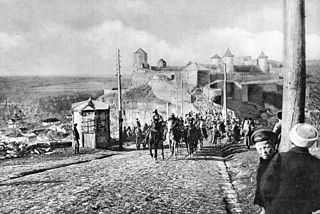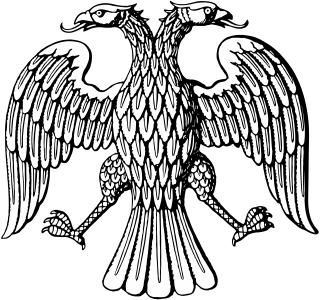| |||||
| Decades: | |||||
|---|---|---|---|---|---|
| See also: | |||||

Events from the year 1918 in Russia
| |||||
| Decades: | |||||
|---|---|---|---|---|---|
| See also: | |||||

Events from the year 1918 in Russia

| | This section needs expansion. You can help by adding to it. (July 2016) |

The Russian Civil War was a multi-party civil war in the former Russian Empire sparked by the overthrowing of the social-democratic Russian Provisional Government in the October Revolution, as many factions vied to determine Russia's political future. It resulted in the formation of the Russian Socialist Federative Soviet Republic and later the Soviet Union in most of its territory. Its finale marked the end of the Russian Revolution, which was one of the key events of the 20th century.

The Treaty of Brest-Litovsk was a separate peace treaty signed on 3 March 1918 between Soviet Russia and the Central Powers, by which Russia withdrew from World War I. The treaty, which followed months of negotiations after the armistice on the Eastern Front in December 1917, was signed at Brest-Litovsk.

The April Theses were a series of ten directives issued by the Bolshevik leader Vladimir Lenin upon his April 1917 return to Petrograd from his exile in Switzerland via Germany and Finland. The theses were mostly aimed at fellow Bolsheviks in Russia and returning to Russia from exile. He called for soviets to seize state power, denounced liberals and social revolutionaries in the Provisional Government, called for Bolsheviks not to cooperate with the government, and called for new communist policies. The April Theses influenced the July Days and October Revolution in the next months and are identified with Leninism.

The Russian Republic, referred to as the Russian Democratic Federal Republic in the 1918 Constitution, was a short-lived state which controlled, de jure, the territory of the former Russian Empire after its proclamation by the Russian Provisional Government on 1 September 1917 in a decree signed by Alexander Kerensky as Minister-Chairman and Alexander Zarudny as Minister of Justice.

The Declaration of the Rights of the Peoples of Russia was a document promulgated by the Bolshevik government of Russia on 15 November 1917 and signed by Vladimir Lenin and Joseph Stalin.
The history of the Communist Party of the Soviet Union was generally perceived as covering that of the Bolshevik faction of the Russian Social Democratic Labour Party from which it evolved. In 1912, the party formally split, and the predecessor to the Communist Party of the Soviet Union became a distinct entity. Its history since then can roughly be divided into the following periods:

The Odessa Soviet Republic was a short-lived Soviet republic formed on 30 January [O.S. 17 January] 1918 from parts of the Kherson and Bessarabia Governorates of the former Russian Empire.

The Ukrainian War of Independence, also referred to as the Ukrainian–Soviet War in Ukraine, lasted from March 1917 to November 1921. It saw the establishment and development of an independent Ukrainian republic, most of which was absorbed into the Ukrainian Soviet Socialist Republic between 1919 and 1920. The Ukrainian Soviet Socialist Republic was one of the constituent republics of the Soviet Union between 1922 and 1991.

The Treaty of Brest-Litovsk was signed on 9 February 1918 between the Ukrainian People's Republic (UPR) and the Central Powers, ending Ukraine's involvement in World War I and recognizing the UPR's sovereignty. The treaty, which followed the armistice on the Eastern Front in December 1917, was signed at Brest-Litovsk. The peace delegation from Soviet Russia, led by Leon Trotsky, did not recognize the UPR delegation, which had been sent from the Central Rada in Kiev, instead recognizing a delegation from the Ukrainian People's Republic of Soviets in Kharkov.
Ion Dic-Dicescu was a Romanian socialist journalist and officer and later Bolshevik activist who held command positions in the Red Army during the Russian Civil War. After the war, he held research positions in the economical domain at several Soviet universities and research institutes, before being executed on accusations of espionage during the Great Purge. His elder son, Iosif Dik, although losing both hands and an eye fighting in the Red Army during World War II, was a successful children's writer in the post-war Soviet Union.

The Ukrainian People's Republic of Soviets was a short-lived (1917–1918) Soviet republic of the Russian SFSR that was created by the declaration of the Kharkiv All-Ukrainian Congress of Soviets "About the self-determination of Ukraine" on 25 December [O.S. 12 December] 1917 in the Noble Assembly building in Kharkov. Headed by the Provisional Workers' and Peasants' Government of Ukraine formed earlier in Russian Kursk. The republic was later united into the Ukrainian Soviet Republic and, eventually, liquidated, because of a cessation of support from the government of the Russian SFSR when the Treaty of Brest-Litovsk was signed.

The Operation Faustschlag, also known as the Eleven Days' War, was a Central Powers offensive in World War I. It was the last major offensive on the Eastern Front.

The All-Russian Congress of Soviets evolved from 1917 to become the supreme governing body of the Russian Soviet Federative Socialist Republic from 1918 until 1936, effectively. The 1918 Constitution of the Russian SFSR mandated that Congress shall convene at least twice a year, with the duties of defining the principles of the Soviet Constitution and ratifying peace treaties. The October Revolution ousted the provisional government of 1917, making the Congress of Soviets the sole, and supreme governing body. This Congress was not the same as the Congress of Soviets of the Soviet Union which governed the whole Soviet Union after its creation in 1922.

The Revolutions of 1917–1923 were a revolutionary wave that included political unrest and armed revolts around the world inspired by the success of the Russian Revolution and the disorder created by the aftermath of World War I. The uprisings were mainly socialist or anti-colonial in nature. Some socialist revolts failed to create lasting socialist states. The revolutions had lasting effects in shaping the future European political landscape, with for example the collapse of the German Empire and the dissolution of Austria-Hungary.

The All Russian Constituent Assembly was a constituent assembly convened in Russia after the February Revolution of 1917. It met for 13 hours, from 4 p.m. to 5 a.m., 18–19 January [O.S. 5–6 January] 1918, whereupon it was dissolved by the Bolshevik-led All-Russian Central Executive Committee, proclaiming the Third All-Russian Congress of Soviets the new governing body of Russia.

The Socialist Revolutionary Party, was a major political party in late Imperial Russia, during both phases of the Russian Revolution, and in early Soviet Russia.

The Ukrainian People's Republic (UPR) was a short-lived state in Eastern Europe. Prior to its proclamation, the Central Council of Ukraine was elected in March 1917 as a result of the February Revolution, and in June, it declared Ukrainian autonomy within Russia. Its autonomy was later recognized by the Russian Provisional Government. Following the October Revolution, the Central Council of Ukraine denounced the Bolshevik seizure of power and proclaimed the Ukrainian People's Republic with a territory including the area of approximately eight Russian imperial governorates. It formally declared its independence from Russia on 22 January 1918.

In March [O.S. February] 1917, the Russian Army formally ceased to be the Imperial Russian Army when Emperor Nicholas II abdicated and the Provisional Government became the governing authority. It was officially a caretaker government until September 1917, when the Russian Republic was proclaimed.
Central Powers intervention in the Russian Civil War consisted of a series of multi-national military expeditions starting in 1918. This intervention was picking up from the Eastern Front against the newly set up Russian Republic. The main goals of the intervention were to maintain the territories received in the Treaty of Brest-Litovsk, prevent a re-establishment of the Eastern Front, and administer new conquered territories. After the defeat of the Central Powers, many armies that stayed mostly helped the Russian White Guard eradicate communists in the Baltics until their eventual withdrawal and defeat. In addition, pro-German factions fought against the newly independent Baltic states until their defeat by the Baltic States, backed by the victorious Allies.

Vladimir Aleksandrovich Karelin was a Russian revolutionary, one of the organizers of the Left Socialist Revolutionary Party and a member of its Central Committee, and People's Commissar of Properties of the Russian Socialist Federative Soviet Republic from December 1917 to March 1918.
![]() Media related to 1918 in Russia at Wikimedia Commons
Media related to 1918 in Russia at Wikimedia Commons